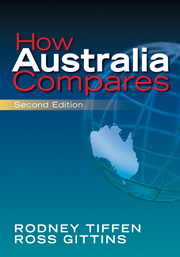Book contents
- Frontmatter
- Contents
- List of tables and figures
- Preface to the second edition
- Acknowledgements
- Reading the tables
- Abbreviations
- Introduction
- 1 People
- 2 Government and politics
- 3 Economics
- 4 Work and labour
- 5 Government taxes and spending
- 6 Health
- 7 Education
- 8 Inequality and social welfare
- 9 International relations
- 10 Environment
- 11 Science and technology
- 12 Telecommunications and computing
- 13 Media
- 14 Family
- 15 Lifestyles and consumption
- 16 Crime and social problems
- 17 The search for scoreboards
- 18 The Howard impact
- Sources and references
8 - Inequality and social welfare
Published online by Cambridge University Press: 05 June 2012
- Frontmatter
- Contents
- List of tables and figures
- Preface to the second edition
- Acknowledgements
- Reading the tables
- Abbreviations
- Introduction
- 1 People
- 2 Government and politics
- 3 Economics
- 4 Work and labour
- 5 Government taxes and spending
- 6 Health
- 7 Education
- 8 Inequality and social welfare
- 9 International relations
- 10 Environment
- 11 Science and technology
- 12 Telecommunications and computing
- 13 Media
- 14 Family
- 15 Lifestyles and consumption
- 16 Crime and social problems
- 17 The search for scoreboards
- 18 The Howard impact
- Sources and references
Summary
Income inequality
National summary measures of economic growth or income take no account of its distribution. They measure the size of the cake, but not how it is divided up. However, distribution is central to people's sense of their well-being, and to their capacity to use the national wealth for their own personal goals.
Table 8.1 uses the most common measure, the Gini coefficient, which takes a value of 0 if every household has identical income and a value of 1 if one household has all the income. Thus an increase in the coefficient represents an increase in inequality.
The Gini coefficient is a ratio measure, which includes all members of a population, and allows comparisons over time and between countries. Generally richer countries such as the selected countries have a lower Gini coefficient than poorer countries. Most Third World countries have coefficients of between .40 and .65, compared with the mean of the selected countries here of just under .30.
This table and Table 8.2 are both taken from the OECD's landmark study published in 2008, Growing Unequal? Income Distribution and Poverty in OECD Countries. This book is the most comprehensive and systematic statistical study of social inequality, and a major advance in scope and methodology.
Table 8.1 shows that Denmark and Sweden are the most equal countries, and the United States the most unequal. The countries fall into two broad groups: nine countries, all European, which in the middle of the 2000s scored between .232 and .276.
- Type
- Chapter
- Information
- How Australia Compares , pp. 136 - 147Publisher: Cambridge University PressPrint publication year: 2009



